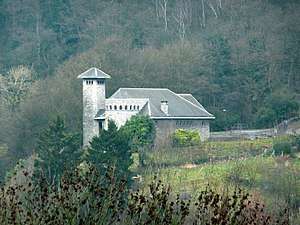Dame Blanche (resistance)
La Dame Blanche (French; literally "The White Lady") was the codename for an underground intelligence network which operated in German-occupied Belgium during World War I. It took its name from a German legend which stated that the fall of the Hohenzollern dynasty would be announced by the appearance of a woman wearing white.
Network

The Dame Blanche network was founded in 1916 by Walthère Dewé, an engineer working in a telegraph and telephone company in Brussels. The decision resulted from the arrest and execution of Dewé's cousin, Dieudonné Lambrecht, who had himself founded an intelligence network codenamed "Lambrecht". In order to save the group, Dewé took control and developed it under the name Dame Blanche.
The network was at first affiliated to the British military intelligence service Cameron Folkstone. After constant infiltration by German counter-espionage it reverted to MI6 at Rotterdam where they were handled by Captain Henry Landau. After the end of the war, Mansfield Smith-Cumming, head of MI6, estimated that Dame Blanche had supplied as much as 70 percent of all military intelligence collected by Allied intelligence services world-wide, not merely that from German-occupied Belgium and northern France.[1]
By the end of the war, its 1,300 agents covered all of occupied Belgium, northern France and, through a collaboration with Louise de Bettignies' network, occupied Luxembourg. The network was known for its high proportion of female members; women may have made up as much as 30 percent of its total personnel.[2]
During the second German occupation of Belgium in World War II, Dewé used the experience of the Dame Blanche network to start a new network, codenamed Clarence.[3] He was shot and killed while trying to avoid capture by the Germans in 1944.

A monument to the Dame Blanche resistance organization has been built near the city of Liège. It is the Chapelle Saint-Maurice (mémorial Walthère Dewé), Rue Coupée 94, Liège, Belgium.[4]
References
- Ruis, Edwin. Spynest. British and German Espionage from Neutral Holland 1914-1918. Briscombe: The History Press, 2016.
- "Walthère Dewé". Les malles ont une mémoire 14-18. Retrieved 2014-04-09.
- "Resistance in Belgium in World War Two". 2013-01-23. Retrieved 2014-04-09.
- "Battlefield Tours". The Belgian Tourist Office – The official website of the Tourism and Convention Bureau of Brussels and Wallonia. Archived from the original on April 13, 2014. Retrieved 2014-04-09.
Further reading
- Decock, Pierre (2011). La Dame Blanche. Un réseau de renseignements de la Grande Guerre. ISBN 9781445297040.
- Decock, Pierre (1987). "La Dame Blanche, 1916-1918". Revue Belge d'Histoire Militaire. 27: 217–26.
- Landau, Henry. Secrets of the White Lady . New York: G.P. Putnam's & Sons, 1935.
- Proctor, Tammy M. Female Intelligence: Women and Espionage in the First World War. New York and London: New York University Press, 2003. 205 pp. ISBN 0-8147-6693-5.
- Ruis, Edwin. Spynest. British and German Espionage from Neutral Holland 1914–1918. Briscombe: The History Press, 2016. ISBN 9780750965064.
External links
- La Dame Blanche at 1914-1918 Online Encyclopedia.